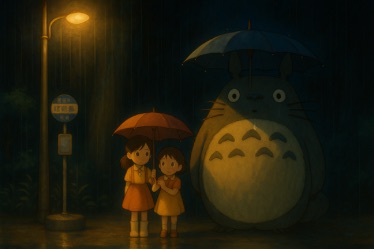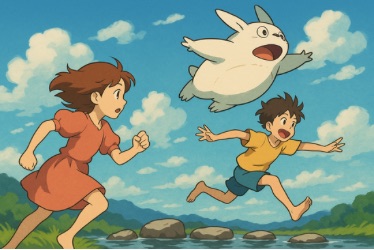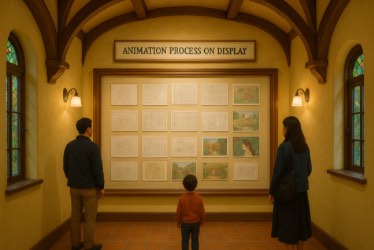You press play on a Studio Ghibli film and the world feels alive. Grass sways, lanterns glow, and water ripples with intent. Without a clear hand, animation can sink into clutter or stiffness, but Hayao Miyazaki’s craft prevents that. His approach turns drawings into believable worlds and shows why careful choices matter at every stage of production. If you skip studying why his work connects, you risk pretty images that do not move anyone. In this post, we will explore his storyboarding process, his use of nature and imagination, his treatment of characters in motion, lessons from the Studio Ghibli Museum, filmography highlights, and his lasting influence on animators everywhere. Taken together, these sections form a roadmap you can adapt in your own practice, showing how everyday details and extraordinary moments meet in animation.
Why Miyazaki Matters
Miyazaki’s films carry weight because the ordinary carries as much importance as the extraordinary. He makes the everyday believable so that the magical can land without strain. In this scene, the heroine, Chihiro, arrives at the bathhouse and is pulled into its workday: steam lines hiss, Kamaji feeds the furnace, soot sprites wobble under coal, and Lin threads trays through tight corridors. The building behaves like a business before anyone names the magic, so when spirits crowd the halls they feel inevitable rather than explained.

Applying this in your own work means giving the room or space a role before fantasy appears. A kettle hisses, a ledger shuts, or a chair scrapes across the floor, and those grounded notes let the unusual stand tall. By anchoring magic in reality, you make it easier for an audience to accept the impossible, and you earn the moment that follows.
From Thumbnails to Scenes: The Storyboarding Habit
Storyboarding is where timing and rhythm are found, not an afterthought to justify choices. For Miyazaki, boards are the film’s spine because beats are discovered in drawings, not pasted on later. In this scene, the young hero, Nausicaä, prepares to launch her glider from a windy ledge. She tightens her scarf, shifts her stance into the gust, holds a breath, and only then commits to the leap. Those beats live in the early boards, so timing is discovered in drawings and the first flight lands because preparation sets the rhythm.

To follow this, sketch storyboards with verbs instead of vague placeholders so intent reads at a glance. Use lean, catch, and breathe to label actions, and let the sequence prove timing before polish. When the “before” is firm, the “after” carries power, and your team aligns on pacing without wasting passes.
Nature as Character (Not Backdrop)
Settings in Miyazaki’s films never sit still or merely decorate the frame. Weather, light, and space act on characters and change what happens next. In this scene, the sisters, Satsuki and Mei, wait for their father at a country bus stop in steady night rain while puddles gather and the road stays quiet. When Totoro arrives, a drop pools on his nose and the umbrella turns into a drum, and the weather drives the moment so a simple wait becomes a memory.

You can practice this by adding a simple note to each shot list: “Environment causes: <blank>.” A gust steals a hat, fog slows a step, or a shaft of light reveals footprints that change the plan. When rooms, weather, and light take actions, the world moves the story forward with you, and texture arrives without extra dialogue.
Characters Built to Move
Strong design and fluid motion define Miyazaki’s characters because gesture and construction always cooperate. His designs read in stillness and survive repetition in motion. In this scene, the heroine, Sophie, newly cursed, navigates the castle’s kitchen as she lifts a heavy kettle, steadies her breath, and drags her hem across the floor while she works. Character is revealed through action long before explanation, and the motion reads cleanly from angle to angle.

Test your own designs with simple, repeatable tasks that reveal truth. Tie a shoe, button a sleeve, or slide a window open, then check whether the gesture reads from three angles on a busy day. Trim fussy lines that wobble, keep one or two signature shapes, and choose a palette you can repeat across shots. When small motions stay clear, larger actions will sing without strain.
The Studio Ghibli Museum: Process on Display
If you want to see choices laid out clearly, the Studio Ghibli Museum in Mitaka pairs rough work with polish so the path is visible. Process sits beside result, and visitors can trace decisions rather than guess at them. In the Animation Room, rough layouts hang beside painted backgrounds with pencil fixes hovering over earlier passes so intent and outcome are both present. In the 3D Zoetrope Room, resin figures spin under strobe lights, and still shapes leap into motion so frame-by-frame becomes something you can read in space.

Borrow that side-by-side method on your projects by pinning roughs next to finals and adding a one-line reason under each change. New teammates align faster because they see the path, not just the destination, and you avoid re-arguing solved problems as sequences evolve. Clear process reduces friction, saves time, and keeps the film’s tone intact.
Filmography Highlights (Watch List)
Small choices carry emotion across the films and evolve with context as stories shift tone and scale. Studying the details reveals how restraint and design carry feeling without noise. In this scene, the traveler, Chihiro, rides a nearly empty train beside her uneasy companion, No-Face, across a flooded plain at dusk. Water slides by the windows, stations appear as silhouettes, and the soft clack of the track holds the feeling without dialogue.

Track recurring tools and note how they change jobs from film to film: wind, food, trains, flight, and work. Keep a notebook and follow a single thread—who cooks, who refuses, who serves, and what changes after—and you will leave with handles you can grab in your own scenes.
- My Neighbor Totoro — everyday wonder, weather as story, child point of view.
- Princess Mononoke — ecology in conflict, creatures with moral weight.
- Spirited Away — transformational spaces, work as character arc.
- Howl’s Moving Castle — architecture with personality, domestic moments in epic stakes.
- Nausicaä of the Valley of the Wind — flight, scale, ecological consequence.
- The Wind Rises — craft obsession, invention, ambiguous progress.
Those touchpoints anchor a watch list with purpose and turn viewing time into study time that pays off on your next sequence.
What You Can Apply This Week
Turning study into skill works best when you prove ideas in small, honest beats. Borrow principles, not surface style, and let clarity come from action you can draw twice. Think of the boiler room in Spirited Away, where steady work and small tasks carry meaning before the big moments arrive and the world teaches you how it operates without speeches.

Here is a quick drill with clear steps so you can practice the same idea this week. Choose one simple action—tie a shoe, pour tea, or open a window—and decide how the environment helps or hinders, such as a quiet table versus a wobbling train or bright morning versus dim evening. Draw three storyboard shots: first, the action begins smoothly; second, something interrupts or the space pushes back; third, the action completes but the environment changes its meaning. Keep lines clean, cut any flourish that does not change feeling or decision, and repeat once a day for five days. Your scenes will breathe, collaborators will read intent faster, and your next pass will need fewer notes.
Want handpicked learning paths that pair classic Ghibli scenes with craft drills you can finish?
Final Thoughts
Miyazaki’s work endures because the ordinary and the impossible meet with care and consistency. Ground the room, let nature act, design for motion, and make process visible so your projects gather quiet strength on their own terms. Make the everyday honest, and the magic will feel inevitable. That lesson runs through his career and can guide your next scene.




























